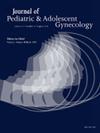5. 新生儿45X/46XY马赛克特纳综合征1例
IF 1.7
4区 医学
Q3 OBSTETRICS & GYNECOLOGY
引用次数: 0
摘要
背景:新生儿生殖器模糊的诊断和处理具有挑战性。我们提出一个2个月大的婴儿非典型生殖器和遗传(45X/46XY)镶嵌。病例:一个健康的婴儿,在妊娠39周无并发症分娩后,被观察到有模糊的生殖器。产前无细胞DNA显示患特纳氏综合症的风险为40%。体格检查显示阴蒂肿大,阴唇襞融合,左侧腹股沟管可触及肿块。盆腔超声显示左侧腹股沟睾丸,未见明显卵巢组织,存在初步的苗勒氏结构。6周时的血清激素评估包括睾酮118.3 ng/dL,抑制素B 139 pg/ml, AMH 32 ng/ml,双氢睾酮30 ng/dL,提示睾丸功能。雌二醇水平为3 pg/mL。细胞遗传学显示45X/46XY与SRY基因嵌合。生殖器图显示有泌尿生殖窦。对潜在的性腺发育不良的担忧增加了,这有恶性肿瘤的风险,并共同决定在麻醉和诊断腹腔镜下进行检查,以评估性腺和苗勒管结构。手术结果包括短的泌尿生殖窦和1厘米的阴道管。正常的单子宫颈可见,左侧睾丸位于腹股沟管。可见右侧条纹性腺(图1A,黑色箭头)、输卵管(图1B,绿色箭头)和小右半子宫(图1D,粉色箭头)。行左侧腹股沟睾丸切除术、左侧腹股沟疝修补术(图1C)和右侧性腺切除术和输卵管切除术(图1)。病理显示卵巢间质为良性,呈尿道样结构。我们描述了一个少数病例的新生儿诊断莫西阿克特纳综合征的存在睾丸和缪勒氏组织。这些病例的诊断挑战是成像方式有限,手术探查通常是确定表型分析所必需的。此外,重要的是要就潜在的结果向父母提供咨询,并鼓励共同决策,在减少可能的恶性肿瘤风险的同时,考虑儿童性别的未来选择。评论-我们报告一例罕见的新生儿45X/46XY马赛克特纳综合征,其手术结果为正常宫颈、泌尿生殖窦、左侧半降睾丸、右侧条纹性腺和输卵管以及半子宫-我们强调在处理罕见、复杂的马赛克特纳综合征时共同决策的作用,包括降低性腺母细胞瘤的风险本文章由计算机程序翻译,如有差异,请以英文原文为准。
5. A rare case of 45X/46XY mosaic Turner syndrome in a neonate
Background
Ambiguous genitalia in a newborn can be challenging to diagnose and manage. We present a case of a 2-month-old infant with atypical genitalia and genetic (45X/46XY) mosaicism.
Case
A healthy infant, delivered after an uncomplicated pregnancy at 39 weeks’ gestation was observed to have ambiguous genitalia. Prenatal cell-free DNA showed 40% risk for Turner's syndrome. A physical exam demonstrated an enlarged clitoris and fusion of the labioscrotal fold with a palpable mass in the left inguinal canal. Pelvic ultrasound showed a left inguinal testicle, no obvious ovarian tissue, and the presence of rudimentary Mullerian structures. Serum hormonal evaluation at 6 weeks of life included a testosterone of 118.3, ng/dL, inhibin B of 139 pg/ml, AMH of 32 ng/ml, and dihydrotestosterone level of 30 ng/dL suggesting testicular function . Estradiol levels were 3 pg/mL. Cytogenetics revealed 45X/46XY mosaicism with an SRY gene. Genitogram demonstrated a urogenital sinus. Concern was raised for potential dysgenetic gonads, which carry a risk for malignancy and a shared decision was made to pursue an exam under anesthesia and diagnostic laparoscopy to assess gonads and mullerian structures. Surgical findings included a short urogenital sinus and a 1 cm vaginal canal. A normal-appearing single cervix was visualized, and the left testicle was identified in the inguinal canal. A right-sided streak gonad (Figure 1A, black arrow), fallopian tube (Figure 1B, green arrow) and small right hemi-uterus (Figure 1D, Pink arrow) were visualized. A left inguinal orchiopexy, left inguinal hernia repair (Figure 1C) and right gonadectomy and salpingectomy (Figure 1) was performed. Pathology showed benign ovarian stroma, with rete-testes like structures. We describe one of the few cases of a neonatal diagnosis of Mosiac Turner's syndrome with the presence of both testicular and Mullerian tissue. The diagnostic challenge of such cases is that imaging modalities are limited, and surgical exploration is often necessary for definitive phenotype analysis. Furthermore, it is important to counsel parents on the potential outcomes and encourage shared decision-making to consider future options for the child's sex of rearing whilst reducing the risk of possible malignancies.
Comments
-We highlight a rare case of neonatal 45X/46XY Mosaic Turner's syndrome with surgical findings of a normal cervix, urogenital sinus, a left semi-descended testicle, right streak gonad and fallopian tube, and hemi-uterus -We highlight the role of shared decision-making when managing rare, complex presentations of mosaic Turner's, including reducing the risk of gonadoblastomas
求助全文
通过发布文献求助,成功后即可免费获取论文全文。
去求助
来源期刊
CiteScore
3.90
自引率
11.10%
发文量
251
审稿时长
57 days
期刊介绍:
Journal of Pediatric and Adolescent Gynecology includes all aspects of clinical and basic science research in pediatric and adolescent gynecology. The Journal draws on expertise from a variety of disciplines including pediatrics, obstetrics and gynecology, reproduction and gynecology, reproductive and pediatric endocrinology, genetics, and molecular biology.
The Journal of Pediatric and Adolescent Gynecology features original studies, review articles, book and literature reviews, letters to the editor, and communications in brief. It is an essential resource for the libraries of OB/GYN specialists, as well as pediatricians and primary care physicians.

 求助内容:
求助内容: 应助结果提醒方式:
应助结果提醒方式:


